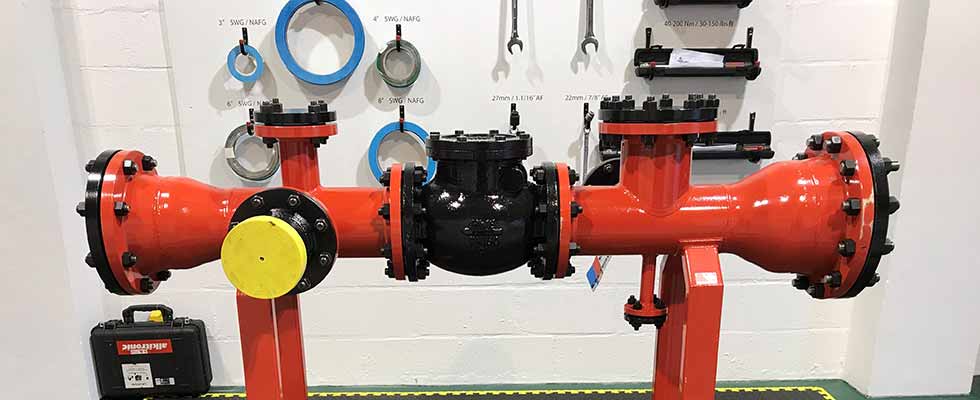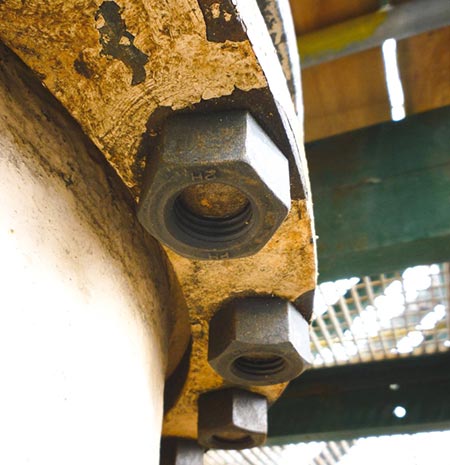
Bolted flange connections are a common method of connecting pipes to process components. They allow access for inspection, maintenance and repair, and can be assembled and disassembled relatively quickly. While the bolted flange connection is, on the surface, a relatively simple mechanical component, the consequence of failure can be severe, causing unwanted downtime, revenue loss and safety concerns. Minor air or water leaks are generally manageable, but if the process fluid is hazardous then there is a risk of harm to personnel or the environment. Major leaks represent a safety hazard and can be expensive since they can result in downtime for the plant.
 IMAGE 1: Example of poor assembly. The nuts are only partially engaged with the threads of the stud, presenting a high potential for failure. (Images courtesy of Phoenix Group)
IMAGE 1: Example of poor assembly. The nuts are only partially engaged with the threads of the stud, presenting a high potential for failure. (Images courtesy of Phoenix Group)Why Flanges Leak
There are numerous factors that can cause a flange joint to leak. These include incorrect gasket selection, damaged bolts and nuts, flanges that are misaligned or too far apart, sealing surface damage and under- or overloading of the gasket. Failure analysis has shown that up to 85 percent of all gasket failures are due to faulty user installation. It is vital that personnel charged with flange assembly have the necessary knowledge and competency to do the job.
The Need for Training
Traditionally, this skill set has been imparted by in-house training conducted by company engineers, or through
practical experience passed down from technician to technician.
While this training is valuable, it can often lack the scope for understanding the numerous considerations at play within the joint. Companies rarely can afford to commit the necessary resources to create and maintain an expert on this broad and detailed subject.
A further issue is that a historical lack of apprenticeships, combined with an aging workforce, has resulted in less skilled personnel being required to do the installation. Without the necessary training, bad practices become ingrained and failures become prevalent.
The good news is that the problem is being addressed, and training programs are available to improve competency in bolted flange assembly. Competency is defined as the ability to undertake responsibilities and perform activities to a recognized standard on a regular basis. It is a combination of skills, experience and knowledge.
The more competent and qualified the personnel involved in making bolted joints become, the greater the reduction of defects that can lead to loss of containment.
Types of Training
There are several options for personnel to attend a recognized bolted flange connection course; the European standard EN1591-4:2013 is perhaps the most comprehensive and can be delivered at company premises. Training approved by the Engineering Construction Industry Training Board (ECITB), such as MJI10, is also a valid option but requires training to be conducted at approved centers.
 IMAGE 2: Typical flange rig used in the hands-on training of a bolted flange connection
IMAGE 2: Typical flange rig used in the hands-on training of a bolted flange connectionFurther options include the updated standard by the American Society of Mechanical Engineers (ASME) PCC-1:2019 regarding Appendix A (“Training and Qualification of Bolted Joint Assembly Personnel”), and the Energy Institute guidelines relating to the integrity of bolted joints for pressurized systems. These are a must to read and digest in terms of setting out a robust joint integrity program.
What to Expect
Formal training programs typically involve a mix of classroom teaching and a practical, hands-on session using a rig, so that candidates leave with the knowledge and practical skills required for dismantling and assembling flanged connections.
Candidates should learn about the various components in the types of joints, gaskets, bolts and lubrication, as well as the necessary skills required in the use of hand torque loading and sequential tightening techniques.
Candidates need to understand the meaning of joint integrity management and the global guidelines and legislation that are required, including identification, inspection and compliance through associated documentation.
Typical Agenda
A typical agenda should cover:
Principles of Bolted Flange Connections
An introduction to the subject; focus on the health and safety aspects of the assembly process; the implication of joint failure; and standards and statutory requirements associated with bolted
flange connections.
Flanges, Bolts & Gaskets
The focus here is on understanding the role of the three major components of the bolted connection. Candidates should learn about the different types of flanges, bolts and gaskets; how they interact with each other; and how they can be compromised if incorrectly selected or assembled.
The Assembly Process
Following proper tightening procedures is critical to leak-free sealing. Focus should be on how to get it right the first time and provide an understanding of the assembly process steps. Topics covered should include joint assembly method and tightening procedures, the principle of bolt stress and the importance of using bolt lubrication for the sealing performance of the joint.
Record Keeping
A key part of the joint integrity process is the preparation of a flange assembly record for each assembled connection, particularly those that are deemed to be in critical service. This training should cover the recording of the bolted joint activity and maintenance of records.
Gasket failures can be problematic, causing downtime, revenue loss and safety concerns. The vast majority of gasket failures are due to improper installation; however, with the correct guidelines and proper training, most of these failures can be preventable.

